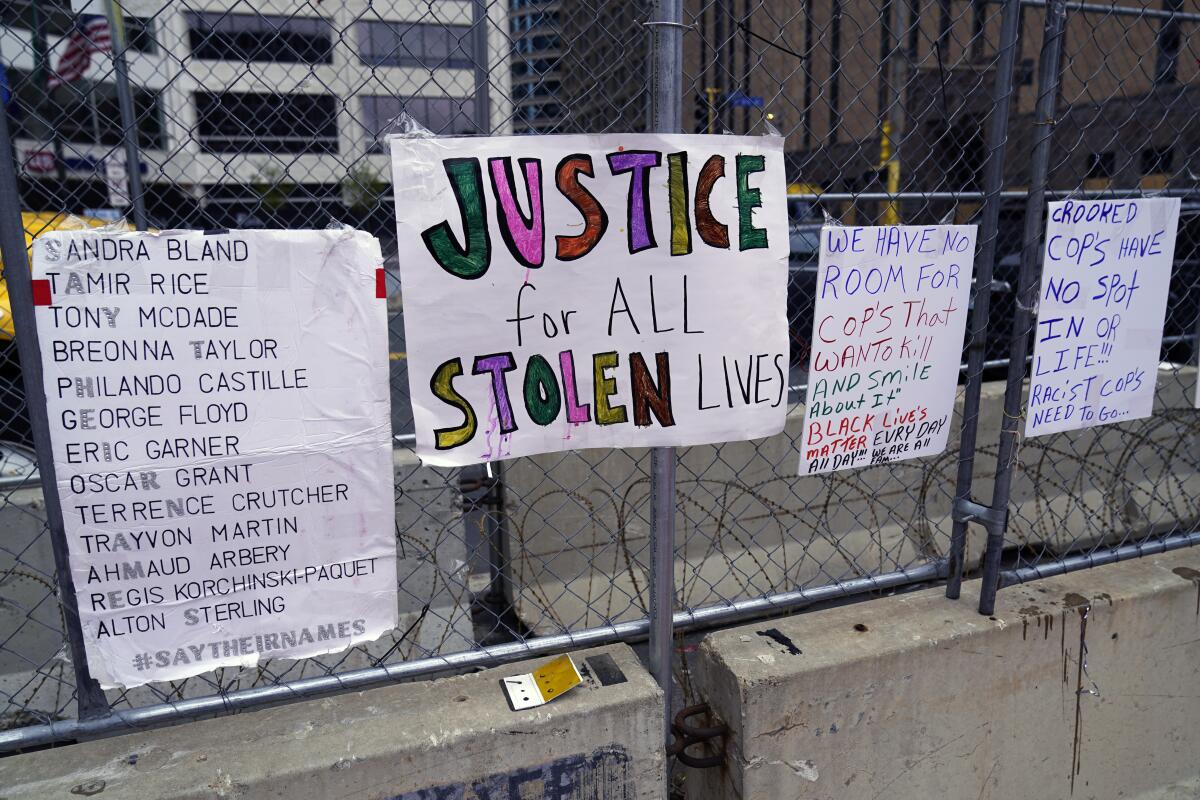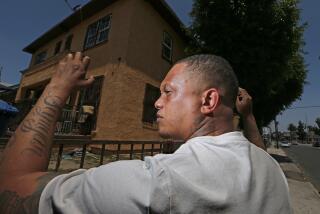A look at high-profile killings by police in the U.S.

- Share via
MINNEAPOLIS — Former Minneapolis Police Officer Derek Chauvin faces decades in prison when he is sentenced Friday for George Floyd’s murder.
A teenage bystander filmed Chauvin pinning Floyd to the street for about 9½ minutes on Memorial Day 2020 as Floyd’s cries of “I can’t breathe” faded to silence. A jury deliberated for parts of two days in April before returning guilty verdicts on murder and manslaughter charges after three weeks of testimony.
Legal experts have said 30 years is likely the most Chauvin, 45, could get without the judge in the case risking being overturned on appeal. And most of those experts thought 20 to 25 years were more likely for the former officer.
It has been rare to charge police with crimes in the death of civilians, and rarer still for them to be convicted. Here’s a look at other high-profile killings by police and the outcome of the case:
Eric Garner
Eric Garner, 43, a Black man, died in July 2014 in New York City after a white officer placed him in a chokehold when Garner refused to be handcuffed for allegedly selling loose, untaxed cigarettes. A Staten Island grand jury declined to indict Officer Daniel Pantaleo in December that year. The Justice Department said in 2019 that it wouldn’t file civil rights charges after a years-long investigation.
Michael Brown
Michael Brown, 18, was fatally shot by a white officer, Darren Wilson, in August 2014 in Ferguson, Mo., touching off weeks of sometimes violent protests. A St. Louis County grand jury declined in November 2014 to indict Wilson in the unarmed Black man’s death, and the U.S. Department of Justice later also declined to charge him. Wesley Bell, the St. Louis County prosecuting attorney, conducted a five-month review of witness statements, forensic reports and other evidence and announced in July that he would not charge Wilson.
Laquan McDonald
Chicago Police Officer Jason Van Dyke shot 16 times at Laquan McDonald, killing the Black 17-year-old as he walked away from officers in October 2014. Van Dyke was charged with first-degree murder the same day the city released the dash-camera video of the shooting. Van Dyke was found guilty of second-degree murder in 2018 and sentenced to nearly seven years in prison.
Tamir Rice
Tamir Rice, 12, was fatally shot by a white Cleveland police officer in November 2014 after officers responded to a 911 call from a man drinking beer and waiting for a bus who said a “guy” was pointing a gun at people. Tamir, who was Black, had a pellet gun tucked in his waistband and was shot after the officers’ cruiser skidded to a stop just feet away. A grand jury in December 2015 declined to indict patrolman Timothy Loehmann, who fired the fatal shot, and training officer Frank Garmback. The U.S. Justice Department announced last year that it would not bring federal criminal charges, saying the quality of video of the shooting was too poor for prosecutors to conclusively establish what had happened.
Walter Scott
Michael Slager, a white South Carolina police officer, shot Walter Scott in the back as the unarmed 50-year-old Black man fled following a 2015 traffic stop. In 2016, a mistrial was declared after the jury deadlocked over a verdict in Slager’s murder trial. The next year, Slager pleaded guilty in federal court to violating Scott’s civil rights and as part of a plea deal, and prosecutors dropped state murder charges. Slager was sentenced to 20 years in prison.
Freddie Gray
Freddie Gray, a 25-year-old Black man, died after he suffered a spinal injury while handcuffed and shackled in a Baltimore police van, sparking weeks of unrest across the city. Three officers were acquitted and prosecutors dropped the remaining state cases in July 2016. The U.S. Department of Justice announced in 2017 that it wouldn’t bring federal charges against the six officers involved in the arrest, saying it did not find enough evidence to prove the officers willfully violated Gray’s civil rights.
Philando Castile
Philando Castile, a 32-year-old elementary school cafeteria worker, was shot five times by a St. Anthony, Minn., police officer during a 2016 traffic stop after Castile informed the officer that he had a gun in the vehicle. The shooting gained widespread attention after Castile’s girlfriend, who was in the car with her then-4-year-old daughter, livestreamed its gruesome aftermath on Facebook. Officer Jeronimo Yanez testified that Castile was pulling his gun out of his pocket despite commands not to do so. The officer was acquitted of manslaughter at trial.
Justine Ruszczyk Damond
Justine Ruszczyk Damond, an unarmed white dual citizen of the U.S. and Australia, was fatally shot in July 2017 by Minneapolis Police Officer Mohamed Noor when she approached his squad car in the alley behind her home minutes after calling 911 to report a possible rape. Noor testified at trial that a loud bang on the squad car startled him and his partner and that he fired to protect his partner’s life. He was convicted of third-degree murder and second-degree manslaughter and sentenced in 2019 to 12½ years in prison.
Jordan Edwards
Roy Oliver, a white Texas police officer, fired at a car full of Black teenagers as it drove away from a large house party in April 2017, fatally shooting 15-year-old Jordan Edwards, who was sitting in the front passenger seat. Police initially said the vehicle backed up toward officers “in an aggressive manner,” but later admitted that body-camera video showed the vehicle was moving forward as officers approached. Oliver was convicted of murder in 2018 and sentenced to 15 years in prison.
Breonna Taylor
Breonna Taylor, a 26-year-old Louisville emergency medical worker studying to become a nurse, was shot several times after three plainclothes narcotics detectives burst into her apartment in the middle of the night in March 2020. A grand jury brought no charges against officers in her death, although one was indicted for shooting into a neighboring home that had people inside. Prosecutors said two officers who fired at Taylor, who was Black, were justified in using force to protect themselves after they faced gunfire from her boyfriend.
More to Read
Sign up for Essential California
The most important California stories and recommendations in your inbox every morning.
You may occasionally receive promotional content from the Los Angeles Times.










